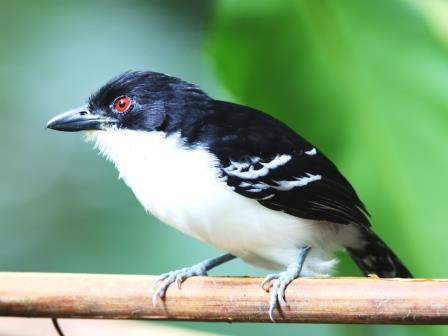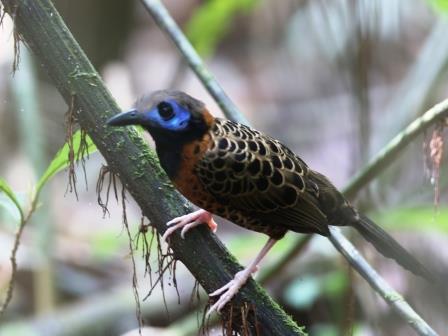– 12nights/13days & Toucan EcoLodge and Wildlife Reserve
Put together your own group and receive significant discounts!
This tour concentrates mainly on the North-East corner of this attractive Central American country. During our travel we will visit several different habitats and will search a long list of amazing Caribbean birding jewels.
We will spend time at Caribbean slopes covered with huge tropical forests, at the most famous, breath-taking Arenal volcano, the unique Cano Negro area close to the Nicaraguan border and at the forests of Volcan Tenorio and crystal-clear waters of Rio Celeste at the Continental Divide.
Beside the several bird species we will surely encounter incredibly rich flora and fauna, including frogs, amphibians, mammals, butterflies, moths, dragonflies and many other bugs and creatures with unimaginable designs. Please note that we can offer different tailor-made itineraries as well depending on your needs.
Fact File
- start and finish in San Jose
- close to 2 weeks of birding in Costa Rica visiting world-famous National Parks and nature reserves
- using 5 accommodations for 2-3nights (except upon arrival/departure), all of them offer great on-site birding
Highlights
- La Virgen de Sarapiqui and La Selva Region
- Arenal Volcano area
- Cano Negro protected area close to Nicaraguan border
- Volcan Tenorio & Rio Celeste area
- wide variety of birds, mammals, reptiles, butterflies & habitats
Accommodation
1 night in or close to San Jose,
3 nights at La Selva or Gavilan – Sarapiqui area,
2 nights at Arenal area,
2 nights at Cano Negro area,
3 nights at Volcano Tenorio & Rio Celeste,
1 night at San Jose,
( 1overnight flight home if you travel to Europe )
Prices
Our price includes
- all travel within the country as noted in the itinerary;
- all accommodation based on shared rooms, single rooms for extra charge;
- 3 meals per day, generally breakfast, packed lunch, dinner (consists of at least two courses);
- services of the leader(s);
- trip materials
Not included
- flights to and from Costa Rica;
- optional programmes to places of interest and entrance fees involved;
- airport and other departure taxes, tips; food beyond generally 3 meals/day;
- excess baggage charges; telephone calls; alcoholic beverages;
- compulsory personal insurance.
Itinerary
– please note that we offer different tour variations & tailor-made tours
Day 1 Arrival to San Jose and transfer to our hotel, birding on site if possible.
Days 2-4 Sarapiqui & La SElva Starting from San Jose we head North to the Sarapiqui and La Selva Region. During our tour La Selva Biological Station will be the first property which belongs to the Organization of Tropical Sciences. It is actually the main centre and the crown jewel of it! Why? Because over 400 species recorded in the area, most of them different from what you can see at other parts of Costa Rica, since this area is on the Caribbean lowlands. Interestingly it is just about 2 hours drive from San Jose. This is one of the best places to see different Tinamu species such as Great, Little & Slatybreasted. Another highlight is Great Green Macaw which we regularly find, sometimes flying over at our accommodation. A wide variety of different bird families can be found here with species such as Crested Guan, Great Curassow, Zone-tailed Hawk, Collared Forest Falcon, Orange-chinned Parakeet, Brown-hooded Parrot, White-crowned Parrot, Red-lored and Mealy Amazon, Vermiculated Screech Owl, Pauraque, Short-tailed Nighthawk, Chimney & Grey-rumped Swift, Purple-crowned Fairy, Cinnamon Hummingbird, Collared Trogon, Slaty-tailed Trogon, Broad-billed Motmot, White-wishkered Puffbird, Rufous-tailed Jacamar, Collared Aracari, Rufouswinged Woodpecker, Chestnut-colored Woodpecker, Lineated & Pale-billed Woodpecker, Streak-headed Woodcreeper, Ochre-bellied Flycatcher, Rufous Mourner, Long-tailed Tyrant, White-ringed Flycatcher, Snowy Cotinga, White-collared Manakin, Rufous-browed Peppershrike, Band-backed Wren, Bay Wren, Goldenwinged Warbler, Hooded Warbler, Bay-headed Tanager, Plain-colored Tanager, Blue Dacnis, Black-faced Grosbeak, Scarlet-rumped Cacique, Chestnut-headed & Montezuma Oropendola.
Days 5-6 Arenal area After a morning birding we travel further North to the nearby Arenal Volcano area. Arenal is one of the most famous volcanoes of Costa Rica and actually quite regularly active as well. The landscape is beautiful, the steep volcanic cone and the nearby Arenal Lake offers a classic panoramic picture. There are several hot springs and more importantly for us excellent birding habitats as well. During our visit we discover different trails at our accommodation and at the Arenal Hanging Bridges, both providing plenty of forest birds including Crested Guan, Great Curassow, Gartered and Orange-bellied Trogon, Broadbilled Motmot and with some luck Prong-billed Barbet or even Great Potoo. There is an outside chance for such rarities like Lovely Cotinga or Bare-necked Umbrellabird. There is a wide range of raptors possible here as well such as Swallow-tailed and Doubletoothed Kite, Bicolored-, Grey-, White- and with extreme luck even Tiny Hawk. Long list of Hummingbirds should be around such as White-necked Jacobin, Blue-throated Goldentail, Bronzy Hermit, Green-breasted Mango and hopefully Black-crested Coquette as well. White-crowned and Red-lored Parrots are quite regularly seen and Olive-throated Parakeet is common. More than half of the total species of Costa Rica occurs in this area so the possibilities are almost endless!
Days 7-8 Cano Negro Lake area After a morning birding and a vitamin rich breakfast, today we travel even further North, very close to the Nicaraguan border. This area is called Cano Negro, another unique protected area and a very different one from the previous ones. This is a huge wetland which is listed as part of the RAMSAR areas, so not just locally, but internationally very important wintering area of masses of birds. We will look for Roseate Spoonbills, Wood Storks, White Ibises and with some luck can find even the huge Jabiru Stork. No question about Anhinga, Northern Jacana and ducks will be represented by Bluewinged Teal and Black-bellied Whistling Duck. Low above the water Lesser Yellow-headed Vultures and Snail Kites search their food. During the days we will also try to find other local specialities as well which live just here, close to the Nicaraguan border such as Nicaraguan Grackle and Nicaraguan Seed-Finch.
Days 9-11 Bijagua at Volcan Tenorio & Rio Celeste close to the Continental Divide The Volcan Tenorio National park covers 12,000 hectares and it is part of the TenorioMiravalles Biological Corridor. The area has a special micro-climate and has a special geographical location as well partly because it is at the dividing line between the Atlantic and Pacific regions and partly because it is between 300 and 2000 meters. We will stay at around 600 or 800 meters. Volcan Tenorio and Celeste Mountain was just recently discovered by birding companies, most of them still do not visit this excellent area despite the fact that more than half of the bird species of Costa Rica can be found here. What is more, not just the variety amazing, but the quality of species as well. Imagine if we could concentrate just on owls theoretically we would have a chance for 10 species! Can’t recall any other area either in CR or outside with that potential. Add to this such sought after species like Tody Motmot, Keel-billed Motmot, Bare-necked Umbrella Bird, Brown-hooded Parrot, Coppery-headed Emerald, White-collared and Whiteruffed Manakin, Green Shrike Vireo, Rufous-winged Tanager, Yellow-eared Toucanet, Three-wattled Bellbird, Dullmantled Ant-bird, Lattice-tailed Trogon, Violaceous and Purplish-backed QuailDove or even Rufous-vented GroundCuckoo – well, any of these would be highlights of the tour. We will surely bird around the road going from Bijagua up towards the National Park. There are always some mix species flocks and sometimes you can find further excellent species such as Lovely Cotinga, White-fronted Nunbird, Lattice-tailed Toucan or Northern Schiffornis. we should always keep an eye on the sky as well and we might be rewarded by an Ornate Hawk-Eagle, White Hawk or Black Hawk-Eagle. Apart from the common Hummingbird species we have a chance for such specialities as Snowcap and Black-crested Coquette, especially if lot of shrubs in flower. The area of the accommodation offers very good birding as well with a long list of species, so we mention just a few such as Barred Antshrike, Bay Wren, several Tanagers like Passerini’s, Silver-throated, Blue-Grey and Hepatic Tanager, Yellow-throated Euphonia, Baltimore Oriole and Black-cheeked Woodpecker. If we can find a good ant-swarm then loads of otherwise hard to see birds can be seen relatively easy as well, including a long list of Antbirds, such as Dullmantled, Ocellated, Spotted, Bicolored and Zeledon’s Antbird. Also in this way it would be easier to see Streak-crowned Antvireo, Buff-throated Foliage-Gleaner, Spotted Woodcreeper, Spotted Barbtail, Golden-crowned Warbler, Rufous-winged Tanager, Song Wren, Tawny-faced Gnatwren, Nightingale Wren or White-throated Spadebill. Motmot here would be represented by Keel-billed, Rufous and Broad-billed Motmot. If we will have time we might visit the trails of Heliconias as well where Long-billed Starthroat is the most commonly seen hummingbird species around the lodge. This would give a second chance for Great Curassow, Crested Guan, Tody Motmot, Black-crested Coquette, Yellow-eared Toucanet, Spotted Antbird, Ocellated Antbird, Streakcrowned Antvireo, Sharpbill, Song Wren, Rufous-vented Ground-Cuckoo. Sometimes Black-and-White Owl hunts at the lights near the lodge entrance, Mottled and Crested Owls are also possible. Pacific Screech Owl can be at the more open fields below the lodge, while further down Tropical Screech Owl replaces it in the town. Barn and Striped Owls are also quite common at deforested areas. If you like Moths you will feel in paradise, there are hundreds of species around every night from tiny one to huge ones, even without a proper moth trap the variety is amazing.
Day 12 Dry habitats of Guanacaste After a last morning birding at this beautiful place we say goodbye to our hosts and to the region and we start our journey towards the capital city. On the way we can make an optional detour depending on the season and actual bird news to some of the dry areas in the Guanacaste province. We can look for species there such as Double-striped Thick-Knee, Banded Wren, Scrub Euphonia, White-throated Magpie-Jay, Stripe-headed Sparrow or Spot-breasted Oriole. With some luck we can even encounter Spot-bellied Bobwhite or Lesser Ground-Cuckoo or Yellow-naped Parrot. Finally we arrive back to our hotel close to the airport but with some local birding possibilities.
Day 13 (-14) Finally return to San Jose airport for your flight and arrive back home next day if you travel to Europe
Put together your own group and receive significant discounts!































